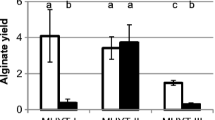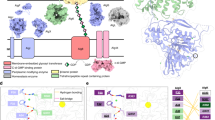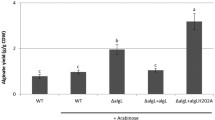Abstract
O-acetylation of alginate produced by the opportunistic human pathogen Pseudomonas aeruginosa significantly contributes to its pathogenesis. Three proteins, AlgI, AlgJ and AlgF have been implicated to form a complex and act together with AlgX for O-acetylation of alginate. AlgI was proposed to transfer the acetyl group across the cytoplasmic membrane, while periplasmic AlgJ was hypothesised to transfer the acetyl group to AlgX that acetylates alginate. To elucidate the proposed O-acetylation multiprotein complex, isogenic knockout mutants of algI, algJ and algF genes were generated in the constitutively alginate overproducing P. aeruginosa PDO300 to enable mutual stability studies. All knockout mutants were O-acetylation negative and complementation with the respective genes in cis or trans restored O-acetylation of alginate. Interestingly, only the AlgF deletion impaired alginate production suggesting a link to the alginate polymerisation/secretion multiprotein complex. Mutual stability experiments indicated that AlgI and AlgF interact independent of AlgJ as well as impact on stability of the alginate polymerisation/secretion multiprotein complex. Deletion of AlgJ did not destabilise AlgX and vice versa. When the alginate polymerase, Alg8, was absent, then AlgI and AlgF stability was strongly impaired supporting a link of the O-acetylation machinery with alginate polymerisation. Pull-down experiments suggested that AlgI interacts with AlgJ, while AlgF interacts with AlgJ and AlgI. Overall, these results suggested that AlgI-AlgJ-AlgF form a multiprotein complex linked via Alg8 to the envelope-spanning alginate polymerisation/secretion multiprotein complex to mediate O-acetylation of nascent alginate. Here, we provide the first insight on how the O-acetylation machinery is associated with alginate production.








Similar content being viewed by others
References
Baker P, Ricer T, Moynihan PJ, Kitova EN, Walvoort MTC, Little DJ, Whitney JC, Dawson K, Weadge JT, Robinson H, Ohman DE, Codée JDC, Klassen JS, Clarke AJ, Howell PL (2014) P. aeruginosa SGNH hydrolase-like proteins AlgJ and AlgX have similar topology but separate and distinct roles in alginate acetylation. PLoS Pathog 10(8):e1004334. https://doi.org/10.1371/journal.ppat.1004334
Baltimore RS, Mitchell M (1980) Immunologic investigations of mucoid strains of Pseudomonas aeruginosa: comparison of susceptibility to opsonic antibody in mucoid and nonmucoid strains. J Infect Dis 141(2):238–247. https://doi.org/10.1093/infdis/141.2.238
Brockelbank JA, Peters V, Rehm BHA (2006) Recombinant Escherichia coli strain produces a ZZ domain displaying biopolyester granules suitable for immunoglobulin G purification. Appl Environ Microbiol 72(11):7394–7397
Franklin MJ, Ohman DE (1993) Identification of algF in the alginate biosynthetic gene cluster of Pseudomonas aeruginosa which is required for alginate acetylation. J Bacteriol 175(16):5057–5065. https://doi.org/10.1128/jb.175.16.5057-5065.1993
Franklin MJ, Ohman DE (1996) Identification of algI and algJ in the Pseudomonas aeruginosa alginate biosynthetic gene cluster which are required for alginate O acetylation. J Bacteriol 178(8):2186–2195. https://doi.org/10.1128/jb.178.8.2186-2195.1996
Franklin MJ, Ohman DE (2002) Mutant analysis and cellular localization of the AlgI, AlgJ, and AlgF proteins required for O acetylation of alginate in Pseudomonas aeruginosa. J Bacteriol 184(11):3000–3007. https://doi.org/10.1128/JB.184.11.3000-3007.2002
Franklin MJ, Chitnis CE, Gacesa P, Sonesson A, White DC, Ohman DE (1994) Pseudomonas aeruginosa AlgG is a polymer level alginate C5-mannuronan epimerase. J Bacteriol 176(7):1821–1830. https://doi.org/10.1128/jb.176.7.1821-1830.1994
Franklin MJ, Douthit SA, McClure MA (2004) Evidence that the algI/algJ gene cassette, required for O acetylation of Pseudomonas aeruginosa alginate, evolved by lateral gene transfer. J Bacteriol 186(14):4759–4773. https://doi.org/10.1128/JB.186.14.4759-4773.2004
Grage K, McDermott P, Rehm BH (2017) Engineering Bacillus megaterium for production of functional intracellular materials. Microb Cell Factories 16(1):211
Gutsche J, Remminghorst U, Rehm BHA (2006) Biochemical analysis of alginate biosynthesis protein AlgX from Pseudomonas aeruginosa: purification of an AlgX-MucD (AlgY) protein complex. Biochimie 88(3):245–251. https://doi.org/10.1016/j.biochi.2005.06.003
Hay ID, Rehman ZU, Rehm BHA (2010a) Membrane topology of outer membrane protein AlgE, which is required for alginate production in Pseudomonas aeruginosa. Appl Environ Microbiol 76(6):1806–1812. https://doi.org/10.1128/AEM.02945-09
Hay ID, Ur Rehman Z, Ghafoor A, Rehm BHA (2010b) Bacterial biosynthesis of alginates. J Chem Technol Biotechnol 85(6):752–759. https://doi.org/10.1002/jctb.2372
Hay ID, Schmidt O, Filitcheva J, Rehm BHA (2012) Identification of a periplasmic AlgK–AlgX–MucD multiprotein complex in Pseudomonas aeruginosa involved in biosynthesis and regulation of alginate. Appl Microbiol Biotechnol 93(1):215–227. https://doi.org/10.1007/s00253-011-3430-0
Hay ID, Wang Y, Moradali MF, Rehman ZU, Rehm BH (2014) Genetics and regulation of bacterial alginate production. Environ Microbiol 16(10):2997–3011
Hoang TT, Karkhoff-Schweizer RR, Kutchma AJ, Schweizer HP (1998) A broad-host-range Flp-FRT recombination system for site-specific excision of chromosomally-located DNA sequences: application for isolation of unmarked Pseudomonas aeruginosa mutants. Gene 212(1):77–86. https://doi.org/10.1016/S0378-1119(98)00130-9
Hoang TT, Kutchma AJ, Becher A, Schweizer HP (2000) Integration-proficient plasmids for Pseudomonas aeruginosa: site-specific integration and use for engineering of reporter and expression strains. Plasmid 43(1):59–72. https://doi.org/10.1006/plas.1999.1441
Jain S, Franklin MJ, Ertesvåg H, Valla S, Ohman DE (2003) The dual roles of AlgG in C-5-epimerization and secretion of alginate polymers in Pseudomonas aeruginosa. Mol Biol 47(4):1123–1133. https://doi.org/10.1046/j.1365-2958.2003.03361.x
Kovach ME, Elzer PH, Steven Hill D, Robertson GT, Farris MA, Roop RM, Peterson KM (1995) Four new derivatives of the broad-host-range cloning vector pBBR1MCS, carrying different antibiotic-resistance cassettes. Gene 166(1):175–176. https://doi.org/10.1016/0378-1119(95)00584-1
Lal A, Haynes SR, Gorospe M (2005) Clean Western blot signals from immunoprecipitated samples. Mol Cell Probes 19(6):385–388
Leid JG, Willson CJ, Shirtliff ME, Hassett DJ, Parsek MR, Jeffers AK (2005) The exopolysaccharide alginate protects Pseudomonas aeruginosa biofilm bacteria from IFN-γ-mediated macrophage killing. J Immunol 175(11):7512–7518. https://doi.org/10.4049/jimmunol.175.11.7512
Lewis JG, Rehm BHA (2009) ZZ polyester beads: an efficient and simple method for purifying IgG from mouse hybridoma supernatants. J Immunol Methods 346(1):71–74. https://doi.org/10.1016/j.jim.2009.04.011
Lyczak JB, Cannon CL, Pier GB (2002) Lung infections associated with cystic fibrosis. Clin Microbiol Rev 15(2):194–222. https://doi.org/10.1128/CMR.15.2.194-222.2002
Mathee K, Ciofu O, Sternberg C, Lindum PW, Campbell JIA, Jensen P, Johnsen AH, Givskov M, Ohman DE, Molin S, Hoiby N, Kharazmi A (1999) Mucoid conversion of Pseudomonas aeruginosa by hydrogen peroxide: a mechanism for virulence activation in the cystic fibrosis lung. Microbiol-Sgm 145:1349–1357. https://doi.org/10.1099/13500872-145-6-1349
May TB, Shinabarger D, Maharaj R, Kato J, Chu L, DeVault JD, Roychoudhury S, Zielinski NA, Berry A, Rothmel RK (1991) Alginate synthesis by Pseudomonas aeruginosa: a key pathogenic factor in chronic pulmonary infections of cystic fibrosis patients. Clin Microbiol Rev 4(2):191–206. https://doi.org/10.1128/CMR.4.2.191
Moradali MF, Donati I, Sims IM, Ghods S, Rehm BHA (2015) Alginate polymerization and modification are linked in Pseudomonas aeruginosa. MBio 6(3):e00453–e00415. https://doi.org/10.1128/mBio.00453-15
Moradali MF, Ghods S, Rehm BHA (2017a) Activation mechanism and cellular localization of membrane-anchored alginate polymerase in Pseudomonas aeruginosa. Appl Environ Microbiol 83(9):e03499–e03416. https://doi.org/10.1128/AEM.03499-16
Moradali MF, Ghods S, Rehm BHA (2017b) Pseudomonas aeruginosa lifestyle: a paradigm for adaptation, survival, and persistence. Front Cell Infect Miicrobiol 7:ARTN 39. https://doi.org/10.3389/fcimb.2017.00039
Nivens DE, Ohman DE, Williams J, Franklin MJ (2001) Role of alginate and its O acetylation in formation of Pseudomonas aeruginosa microcolonies and biofilms. J Bacteriol 183(3):1047–1057. https://doi.org/10.1128/JB.183.3.1047-1057.2001
Pier GB, Coleman F, Grout M, Franklin M, Ohman DE (2001) Role of alginate O acetylation in resistance of mucoid Pseudomonas aeruginosa to opsonic phagocytosis. Infect Immun 69(3):1895–1901. https://doi.org/10.1128/IAI.69.3.1895-1901.2001
Rehm BHA (2010) Bacterial polymers: biosynthesis, modifications and applications. Nat Rev Microbiol 8:578–592. https://doi.org/10.1038/nrmicro2354
Rehm BHA, Valla S (1997) Bacterial alginates: biosynthesis and applications. Appl Microbiol Biotechnol 48(3):281–288. https://doi.org/10.1007/s002530051051
Rehm BHA, Boheim G, Tommassen J, Winkler UK (1994a) Overexpression of Alge in Escherichia-coli - subcellular-localization, purification, and ion-channel properties. J Bacteriol 176(18):5639–5647
Rehm BHA, Grabert E, Hein J, Winkler UK (1994b) Antibody-response of rabbits and cystic-fibrosis patients to an alginate-specific outer-membrane protein of a mucoid strain of Pseudomonas aeruginosa. Microb Pathog 16(1):43–51. https://doi.org/10.1006/mpat.1994.1004
Rehman ZU, Rehm BHA (2013) Dual roles of Pseudomonas aeruginosa AlgE in secretion of the virulence factor alginate and formation of the secretion complex. Appl Environ Microbiol 79(6):2002–2011. https://doi.org/10.1128/AEM.03960-12
Rehman ZU, Wang Y, Moradali MF, Hay ID, Rehm BHA (2013) Insights into the assembly of the alginate biosynthesis machinery in Pseudomonas aeruginosa. Appl Environ Microbiol 79(10):3264–3272. https://doi.org/10.1128/AEM.00460-13
Remminghorst U, Rehm BHA (2006a) Alg44, a unique protein required for alginate biosynthesis in Pseudomonas aeruginosa. FEBS Lett 580(16):3883–3888. https://doi.org/10.1016/j.febslet.2006.05.077
Remminghorst U, Rehm BHA (2006b) Bacterial alginates: from biosynthesis to applications. Biotechnol Lett 28(21):1701–1712. https://doi.org/10.1007/s10529-006-9156-x
Remminghorst U, Rehm BHA (2006c) In vitro alginate polymerization and the functional role of Alg8 in alginate production by Pseudomonas aeruginosa. Appl Environ Microbiol 72(1):298–305. https://doi.org/10.1128/AEM.72.1.298-305.2006
Remminghorst U, Hay ID, Rehm BHA (2009) Molecular characterization of Alg8, a putative glycosyltransferase, involved in alginate polymerisation. J Bacteriol 140(3):176–183. https://doi.org/10.1016/j.jbiotec.2009.02.006
Riley LM, Weadge JT, Baker P, Robinson H, Codée JD, Tipton PA, Ohman DE, Howell PL (2013) Structural and functional characterization of Pseudomonas aeruginosa AlgX: role of AlgX in alginate acetylation. J Biol Chem 288(31):22299–22314
Robles-Price A, Wong TY, Sletta H, Valla S, Schiller NL (2004) AlgX is a periplasmic protein required for alginate biosynthesis in Pseudomonas aeruginosa. J Bacteriol 186(21):7369–7377. https://doi.org/10.1128/JB.186.21.7369-7377.2004
Schweizer HP, Hoang TT (1995) An improved system for gene replacement and xylE fusion analysis in Pseudomonas aeruginosa. Gene 158(1):15–22. https://doi.org/10.1016/0378-1119(95)00055-B
Shinabarger D, May TB, Boyd A, Ghosh M, Chakrabarty AM (1993) Nucleotide sequence and expression of the Pseudomonas aeruginosa algF gene controlling acetylation of alginate. Mol Microbiol 9(5):1027–1035. https://doi.org/10.1111/j.1365-2958.1993.tb01232.x
Simon R, Priefer U, Puhler A (1983) A broad host range mobilization system for in vivo genetic-engineering - transposon mutagenesis in gram-negative bacteria. Bio-Technol 1(9):784–791. https://doi.org/10.1038/nbt1183-784
Simpson JA, Smith SE, Dean RT (1988) Alginate inhibition of the uptake of Pseudomonas aeruginosa by macrophages. J Gen Microbiol 134(1):29–36. https://doi.org/10.1099/00221287-134-1-29
Simpson JA, Smith SE, Dean RT (1989) Scavenging by alginate of free radicals released by macrophages. Free Radical Bio Med 6(4):347–353. https://doi.org/10.1016/0891-5849(89)90078-6
Song Z, Wu H, Ciofu O, Kong K-F, Høiby N, Rygaard J, Kharazmi A, Mathee K (2003) Pseudomonas aeruginosa alginate is refractory to Th1 immune response and impedes host immune clearance in a mouse model of acute lung infection. J Med Microbiol 52(9):731–740. https://doi.org/10.1099/jmm.0.05122-0
Tan J, Rouse SL, Li D, Pye VE, Vogeley L, Brinth AR, El Arnaout T, Whitney JC, Howell PL, Sansom MSJACSDBC (2014) A conformational landscape for alginate secretion across the outer membrane of Pseudomonas aeruginosa. Acta Crystallogr D 70(8):2054–2068
Wang YJ, Moradali MF, Goudarztalejerdi A, Sims IM, Rehm BHA (2016) Biological function of a polysaccharide degrading enzyme in the periplasm. Sci Rep-Uk. https://doi.org/10.1038/srep31249
Waters V, Smyth A (2015) Cystic fibrosis microbiology: advances in antimicrobial therapy. J Cyst Fibros 14(5):551–560. https://doi.org/10.1016/j.jcf.2015.02.005
Whitney JC, Hay ID, Li C, Eckford PDW, Robinson H, Amaya MF, Wood LF, Ohman DE, Bear CE, Rehm BH, Lynne Howell P (2011) Structural basis for alginate secretion across the bacterial outer membrane. Proc Natl Acad Sci U S A 108(32):13083–13088. https://doi.org/10.1073/pnas.1104984108
Whitney JC, Whitfield GB, Marmont LS, Yip P, Neculai AM, Lobsanov YD, Robinson H, Ohman DE, Howell PL (2015) Dimeric c-di-GMP is required for post-translational regulation of alginate production in Pseudomonas aeruginosa. J Biol Chem 290(20):12451–12462
Wolfram F, Kitova EN, Robinson H, Walvoort MT, Codée JD, Klassen JS, Howell PL (2014) Catalytic mechanism and mode of action of the periplasmic alginate epimerase AlgG. J Biol Chem 289(9):6006–6019
Funding
This study was supported by research grants to B.H.A.R. from Griffith University.
Author information
Authors and Affiliations
Corresponding author
Ethics declarations
Competing interests
The authors declare that they have no competing interests.
Ethical approval
This article does not contain any studies with human participants or animals performed by any of the authors.
Additional information
Publisher’s note
Springer Nature remains neutral with regard to jurisdictional claims in published maps and institutional affiliations.
Electronic supplementary material
ESM 1
(DOCX 1081 kb)
Rights and permissions
About this article
Cite this article
Chanasit, W., Gonzaga, Z.J.C. & Rehm, B.H.A. Analysis of the alginate O-acetylation machinery in Pseudomonas aeruginosa. Appl Microbiol Biotechnol 104, 2179–2191 (2020). https://doi.org/10.1007/s00253-019-10310-6
Received:
Revised:
Accepted:
Published:
Issue Date:
DOI: https://doi.org/10.1007/s00253-019-10310-6




